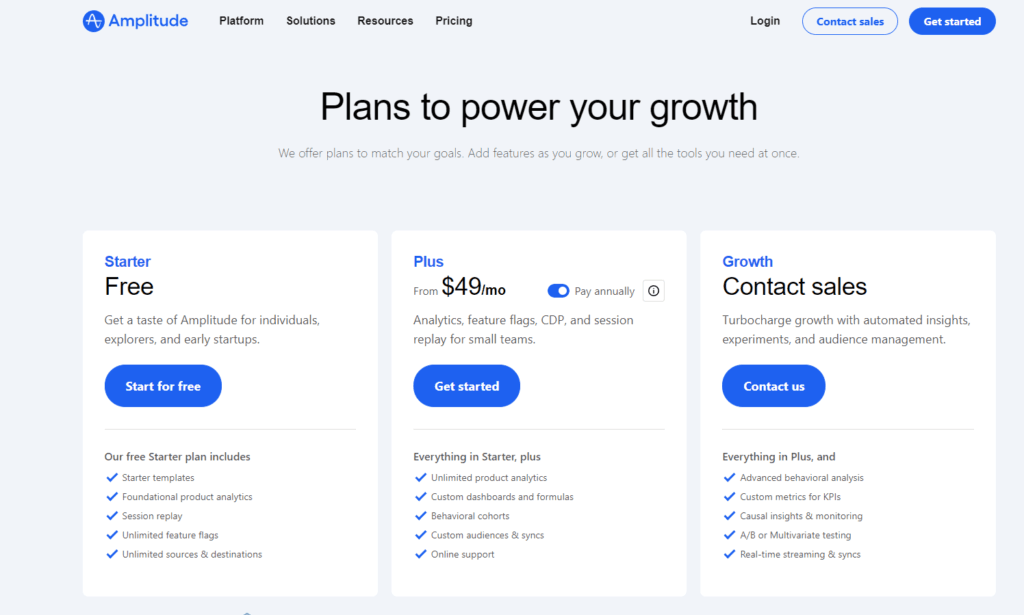In the bustling digital marketplace, understanding your audience isn’t just beneficial—it’s essential. Like a captain navigating through uncharted waters, you need the right tools to guide your voyage. That’s where Hotjar and Amplitude come into the picture, serving as your compass and sextant in understanding user behavior. But which tool is the right one for your journey? Let’s embark on an exploration to uncover which analytics tool best suits your needs, ensuring your digital strategy is on course for success.
| Hotjar | Amplitude |
|---|---|
 |  |
| G2 Score – 4.3 out of 5 stars | G2 Score – 4.5 out of 5 stars |
| TrustRadius Score – 8.2/10 | TrustRadius Score – 8.3/10 |
Ease of Use and Accessibility
Navigating the Dashboard Seas
When it comes to choosing between Hotjar and Amplitude, think of yourself as a sailor deciding between two ships. One might be faster and more agile (Hotjar), while the other offers more power and capacity for long voyages (Amplitude). But before we set sail, let’s explore how user-friendly and accessible these vessels are.
Hotjar: The Agile Schooner
Hotjar, much like a swift schooner, prides itself on simplicity and speed. Designed with user experience at its core, Hotjar’s dashboard is intuitive, making it easy for digital marketers, UX designers, and product managers to quickly find the insights they need. From heatmaps that show where users are clicking, to session recordings that offer a play-by-play of the user journey, Hotjar translates complex data into visually compelling and actionable insights.
The platform’s straightforward setup means you can start collecting data almost immediately, without needing a crew of data scientists. For small to medium-sized businesses, or those just beginning to focus on website optimization, Hotjar’s ease of use is like catching a favorable wind, helping you swiftly move towards your goals.
Amplitude: The Sturdy Galleon
Amplitude, on the other hand, is like a sturdy galleon built for deep explorations. It offers a robust set of features designed for digging deep into user behavior and product analytics. With Amplitude, you can segment users, track cohorts over time, and understand complex funnels and user paths. However, this power comes with complexity. Navigating Amplitude’s dashboard and fully leveraging its analytical capabilities might require a more experienced hand, or at least a willingness to climb the steep learning curve.
This tool is particularly suited for medium to large enterprises or tech-savvy startups that are ready to invest the time and resources into understanding their product usage at a granular level. With Amplitude, the insights are vast and deep, but you’ll need to be prepared to man the sails and navigate through the rich data seas it offers.
Insights and Analytics
The Compass for Decision Making
In the quest for digital excellence, having a detailed map of user behavior is invaluable. It’s not just about where your users click or how they navigate your site; it’s about understanding their journey to make data-driven decisions. Let’s delve into how Hotjar and Amplitude fare in uncovering these insights.
Hotjar: The Art of Visual Storytelling
Hotjar excels in visual storytelling, making it easier for teams to understand user behavior without drowning in numbers. Imagine being able to watch a movie of your users’ sessions, seeing exactly where they hesitate, get confused, or drop off. This is the power of Hotjar. It translates complex user interactions into intuitive visual formats, such as heatmaps and session recordings, which illuminate the user experience in vivid detail.
This visual approach to analytics is particularly effective for teams focused on optimizing web pages, improving funnel conversions, and enhancing overall user satisfaction. For instance, if a new feature on your website is underperforming, Hotjar’s session recordings can reveal if users are interacting with it as expected, or if design flaws are hindering its effectiveness. Similarly, heatmaps can show whether important content is being overlooked due to poor placement or if a call-to-action button isn’t as noticeable as it should be.
The actionable insights derived from Hotjar are most impactful when used to make immediate, user-experience-driven decisions. It’s about identifying and solving specific problems that directly affect how users engage with your site. This focus on the qualitative aspects of user behavior makes Hotjar an invaluable tool for teams that prioritize direct feedback and rapid iteration based on user interactions.
Amplitude: The Science of Deep Data Analysis
Where Hotjar paints a picture of user behavior, Amplitude constructs a detailed map of user interactions across your digital products. Amplitude’s strength lies in its ability to dissect vast amounts of data to reveal the underlying patterns and trends that drive user engagement and retention. Through segmentation, cohort analysis, and event tracking, Amplitude provides a granular view of how different user groups interact with your product over time.
Amplitude’s insights are particularly valuable for product managers and data analysts focused on long-term strategy and optimization. By understanding the complete user journey, from initial acquisition through to retention and churn, Amplitude helps you identify the levers that can be adjusted to improve key metrics. For example, cohort analysis can reveal how changes to your onboarding process affect long-term user retention, while event tracking can show how specific features contribute to user engagement.
The depth of insights offered by Amplitude requires a more analytical approach to decision-making. It’s about looking beyond the immediate reactions of users and understanding the broader trends and behaviors that indicate product health. This level of analysis is crucial for businesses aiming to scale their operations and evolve their products based on comprehensive user insights.
Scalability and Flexibility
Charting a Course for Growth
In the dynamic world of digital business, your analytics tool should be a steadfast companion that evolves alongside your enterprise. Whether you’re expanding your website, launching new products, or entering new markets, the tool must adapt and scale accordingly.
Hotjar: Growing With Your User Insights Needs
Hotjar is akin to a nimble vessel that’s built for speed and maneuverability, making it an excellent choice for startups and small to medium-sized businesses at the outset of their journey. Its platform is designed to be straightforward, ensuring that as your business grows, scaling your user insights efforts remains intuitive. Hotjar’s model allows for an easy start with basic plans that can grow as you do, offering more robust options tailored to larger datasets and more sophisticated analysis needs as your traffic increases.
The flexibility of Hotjar shines through its user-centric features, such as heatmaps, session recordings, and surveys, which continue to provide value without necessitating a steep learning curve as your business scales. This ensures that businesses can maintain a pulse on user behavior and feedback, crucial for iterative design and development processes, even as the volume of data and the complexity of questions increase.
Amplitude: Engineered for Scale and Complexity
Amplitude, by contrast, is built like a formidable ocean liner, engineered to navigate the vast oceans of data that large enterprises or rapidly growing companies might encounter. It stands out for its robustness and ability to scale effortlessly with your business’s growth. Amplitude is designed to handle massive volumes of data across various user interactions, making it a preferred choice for businesses that foresee a significant scaling of their digital operations or those already operating at scale.
This tool’s flexibility is evident in its comprehensive analytics capabilities, which allow for deep dives into user segmentation, behavior tracking, and predictive modeling. As your company grows, Amplitude’s advanced features become increasingly valuable, offering nuanced insights that can drive strategic decisions. The platform’s capacity to integrate with a multitude of other tools and systems further ensures that it can adapt to the evolving tech stack of a growing business, maintaining a central role in your analytics ecosystem.

Related: Check out our free SEO suite

Integration Capabilities
Charting the Digital Ecosystem
In the vast ocean of digital tools, your analytics platform should act as a lighthouse, seamlessly guiding data from various sources to provide comprehensive insights. The ease with which an analytics tool integrates with other platforms can dramatically enhance its utility and the value it brings to your digital strategy.
Hotjar: Streamlining Essential Connections
Hotjar, much like a versatile clipper ship, offers straightforward and efficient integration options that cover the essentials without overwhelming complexity. It seamlessly connects with most website platforms, including popular content management systems (CMS) like WordPress, Shopify, and Wix. This ease of integration ensures that you can quickly set up Hotjar on your site and start gathering insights without a significant technical lift.
Additionally, Hotjar complements these direct integrations with the ability to work alongside other analytics tools, such as Google Analytics. This capability allows you to layer Hotjar’s qualitative insights over the quantitative data from Google Analytics, providing a fuller picture of user behavior without needing to juggle multiple data sources manually.
Amplitude: Navigating Advanced Integrations
Amplitude, akin to a robust flagship, boasts a broad array of integration capabilities designed for more advanced and technical users. Its strength lies in the ability to integrate deeply with a wide variety of data sources, including other analytics platforms, marketing automation tools, and even custom data pipelines. This wide net of integrations is crucial for businesses that rely on a diverse set of tools and platforms to understand their users comprehensively.
Amplitude’s API and SDKs offer flexibility for custom integrations, allowing businesses to tailor the analytics setup to their unique ecosystem. This capability is particularly valuable for tech-centric companies or those with specific needs that off-the-shelf solutions cannot meet. By enabling a seamless flow of data between Amplitude and other tools, businesses can create a centralized analytics command center, empowering them to make data-driven decisions across all aspects of their digital presence.
Pricing and Scalability
Charting Your Growth Path
In the vast ocean of digital analytics, the cost of your tools and their ability to scale with your business are like the winds that propel your ship. Too little wind, and you’re stuck; too much, and you might find yourself off course. Let’s navigate through the pricing structures and scalability options of Hotjar and Amplitude to find the right balance for your journey.
Hotjar: The Tailwind for Small to Medium Vessels

Hotjar is often hailed for its straightforward pricing model, designed to cater to a wide range of businesses, from small startups to larger enterprises. With its tiered pricing plans, Hotjar allows you to start with a basic, cost-effective option and scale up as your needs grow. This makes it an attractive choice for businesses that are just beginning their analytics voyage or those with more modest requirements.
The platform offers a free version with limited capabilities, which is perfect for small websites or businesses looking to dip their toes into understanding user behavior without committing a significant portion of their budget. As your business grows and your analytics needs become more sophisticated, you can easily upgrade to Hotjar’s Plus, Business, or even Scale plans, each offering increased limits on sessions, reports, and users, along with advanced features like longer data retention and additional team seats.
Amplitude: Navigating the Open Seas of Large-Scale Analytics

Amplitude, with its emphasis on in-depth analytics and product optimization, presents a pricing model that reflects its value to medium-sized businesses and large enterprises. While Amplitude offers a free starter plan, its true power is unlocked with its premium offerings, which are tailored to businesses ready to invest in a comprehensive analytics solution.
The platform’s pricing is based on the volume of data you track, which means it can scale with your business. This model is ideal for organizations with high volumes of user interactions that require detailed analysis. As your business grows, so does your data – and Amplitude is built to handle that growth, providing deeper insights into increasingly complex user behaviors.
Amplitude’s scalability is a significant advantage for businesses projecting rapid growth or those with already substantial user bases. It ensures that as your needs evolve, your analytics tool can keep pace, offering the sophisticated features and support required to extract valuable insights from vast data sets.
Conclusion
Hotjar: The Agile Explorer
Hotjar emerges as the agile explorer, perfectly suited for businesses and teams seeking straightforward, intuitive insights into user behavior. With its focus on visual analytics like heatmaps and session recordings, Hotjar offers a user-friendly gateway to understanding the ‘why’ behind user actions. Its simplicity, combined with effective user feedback mechanisms, makes it an excellent choice for small to medium-sized businesses, startups, or any organization prioritizing quick, actionable insights to enhance user experience and website performance.
Amplitude: The Deep-Diving Navigator
Amplitude, on the other hand, is the deep-diving navigator, designed for businesses that require comprehensive analytics capabilities. Its robust platform excels in uncovering complex user behavior patterns, segmentation, and long-term trend analysis, making it ideal for medium to large enterprises or tech-centric startups poised for rapid growth. Amplitude’s strength lies in its ability to scale and its flexibility in integrating with a broad digital toolset, supporting a data-driven approach to product development and marketing strategy.
Read Next:
- Why Website Accessibility Matters in Healthcare SEO
- The Role of Website Architecture in Healthcare SEO
- Page Speed and its Impact on SEO for Healthcare Websites
- Creating an SEO-Friendly User Journey for Healthcare Businesses
- 31+ Top Social Media Management tools Compared! (2023)






















Comments are closed.